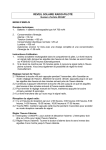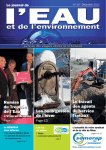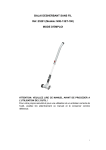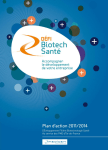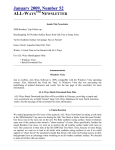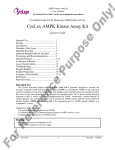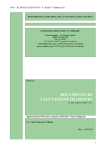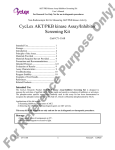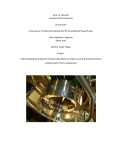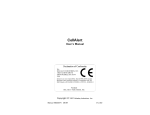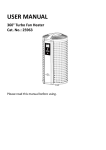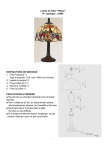Download CY-1185
Transcript
On ly! CaMKK beta Kinase Assay Kit User’s Manual For Research Use Only, Not for use in diagnostic procedures Non-Radioisotopic Kit for Measuring CaMKKβ Activity CycLex CaMKK beta Kinase Assay Kit Pu rp Intended Use................................................ 1 Storage......................................................... 1 Introduction.................................................. 2 Principle of the Assay.................................. 2-3 Materials Provided....................................... 4 Materials Required but not Provided........... 5 Precautions and Recommendations............. 6 Detailed Protocol......................................... 7-11 Evaluation of Results..................…............ 12 Assay Characteristics.................................. 12 Troubleshooting.......................................... 12 Reagent Stability......................................... 12 Sample Preparation..................................... 13 Example of Test Result............................... 14-16 References................................................... 17 Related Products.......................................... 17 os e Cat# CY-1185 Intended Use en ce The CycLex Research Product CycLex CaMKK beta Kinase Assay Kit is primarily designed to measure the activities of purified Ca2+/calmodulin-dependent protein kinase kinase beta (CaMKKβ) or recombinant CaMKKβ for the rapid and sensitive evaluation of activators or inhibitors. The phospho-threonine specific monoclonal antibody used in this assay kit has been demonstrated to recognize the phospho-threonine 183 in adenosine monophosphate-activated protein kinase (AMPK) α1/the phospho-threonine 172 in AMPKα2, which is efficiently phosphorylated by CaMKKβ. Additionally, column fractions of cultured primary cells, cell lines, or tissues can be assayed for CaMKKβ activity with the CycLex Research Product CycLex CaMKK beta Kinase Assay Kit if the appropriate dose of CaMKKβ specific inhibitor, e.g. STO-609, is used. er Applications of this kit include: 1) Screening activators or inhibitors of CaMKKβ. 2) Evaluating the effects of pharmacological agents on CaMKKβ activity in vitro. 3) Monitoring the purification of CaMKKβ activity. ef This assay kit is for research use only and not for use in diagnostic or therapeutic procedures. Storage rR • Upon receipt store all components at 4°C. • Don’t expose reagents to excessive light. Fo Cat#: CY-1185 1 Version#: 141107 On ly! CaMKK beta Kinase Assay Kit User’s Manual For Research Use Only, Not for use in diagnostic procedures Introduction os e The AMP-activated protein kinase (AMPK) is a critical regulator of energy homeostasis, and is a potential target for treatment of metabolic diseases as well as cancer (1). Activation of AMPK requires phosphorylation of threonine 172 within the T loop region of the catalytic α2 subunit by the tumor suppressor LKB1 (2, 3) or the Ca2+/calmodulin-dependent protein kinase kinase beta (CaMKKβ) (4-6). CaMKKβ can form a complex with and activate AMPK, but CaMKKα cannot. In addition, it was shown that CaMKKβ and AMPK associate through their kinase domains, and CaMKKβ must be in an active conformation in order to bind AMPK but not to associate with an alternative substrate, Ca2+/calmodulin-dependent protein kinase IV. In contrast to LKB1, the activation of AMPK by CaMKKβ does not require an alteration of the ATP:AMP ratio, but rather occurs in response to an increase in intracellular Ca2+. The expression pattern of CaMKKβ in cells and tissues is more limited than that of LKB1 and is highest in multiple regions of the brain (7). Principle of the Assay rR ef er en ce Pu rp The CycLex Research Product CycLex CaMKK beta Kinase Assay Kit is a semi-quantitative immunoassay for CaMKKβ activity. This product can be used to determine the presence of CaMKKβ activity in purification column fractions or to follow the kinetics of a purified or partially purified CaMKKβ protein as well as screening CaMKKβ inhibitor or activator. The protocol for the quantitative measurement of CaMKKβ kinase activity involves incubation of the CaMKKβ sample with its substrate, AMPKα1-GST-fusion protein, in the presence of Mg2+and ATP, followed by transfer this kinase reaction mixture to the well of microtiter plate, which has been pre-coated with a monoclonal antibody specific for phospho-AMPKα1 T183/AMPKα2 T172 for trapping only phosphorylated substrate. The amount of phosphorylated substrate on the well is measured by a horseradish peroxidase conjugated antibody specific for AMPKα1, which then catalyzes the conversion of the chromogenic substrate tetra-methylbenzidine (TMB) from a colorless solution to a blue solution (or yellow after the addition of stopping reagent). The color is quantified by spectrophotometry and reflects the relative amount of CaMKKβ activity in the sample. For kinetic analysis, the CaMKKβ-containing sample is added to the wells in a similar fashion and at varying times the reaction is stopped by the addition of the chelator, sodium ethylenediaminetetraacetate (EDTA) and the amount of phosphorylated substrate determined as before. The CycLex Research Product CycLex CaMKK beta Kinase Assay Kit is designed to accurately determine the presence and relative amount of CaMKKβ activity in purification column fractions and to determine non-isotopic kinetic analysis of CaMKKβ activity. Careful attention to extraction methods and the assay protocol will provide the investigator with a reliable tool for the evaluation of CaMKKβ activity. Fo Cat#: CY-1185 2 Version#: 141107 Summary of Procedure On ly! CaMKK beta Kinase Assay Kit User’s Manual For Research Use Only, Not for use in diagnostic procedures Add 100 µL of reaction mixtures to the non-coated wells. Incubate for 1 hour at 30°C. os e Add of 10 µL of EDTA Solution to stop kinase reaction. Transfer 100 µL of reaction mixtures to the antibody-coated wells. Wash the wells. Pu rp Incubate for 1 hour at room temp. ce Add 100 µL of HRP conjugated anti-AMPKα1 antibody. Incubate for 1 hour at room temp. en Wash the wells. Add 100 µL of Substrate Reagent. er Add 100 µL of Stop Solution. rR ef Measure absorbance at 450 nm. Fo Cat#: CY-1185 3 Version#: 141107 On ly! CaMKK beta Kinase Assay Kit User’s Manual For Research Use Only, Not for use in diagnostic procedures Materials Provided All samples and standards should be assayed in duplicate. The following components are supplied and are sufficient for the one 96-well microplate kit. Non-coated Microplate: One microplate supplied ready to use for kinase reaction, with 96 wells (12 strips of 8-wells) in a clear, zip-lock bag. os e Antibody-coated Microplate: One microplate supplied ready to use, with 96 wells (12 strips of 8-wells) in a foil, zip-lock bag with a desiccant pack. Wells are coated with anti-phospho-AMPKα1 T183 / AMPKα2 T172 monoclonal antibody as a capture antibody. 10X Wash Buffer: One bottle containing 100 mL of 10X buffer containing 2%Tween®-20 Kinase Buffer: One bottle containing 20 mL of 1X buffer, used for Reaction Buffer and sample dilution. Pu rp 20X ATP: One vial of lyophilized ATP Na2 salt. 20X DTT: Two vials of lyophilized dithiothreitol. 20X BSA: One vial of lyophilized BSA. 100X Calmodulin: One vial of lyophilized calmodulin, used for Reaction Buffer (Ca2+/CaM plus). 50X CaCl2: One vial containing 0.4 mL of 125 mM CaCl2, used for Reaction Buffer (Ca2+/CaM plus). ce 50X EGTA: One vial containing 0.4 mL of 100 mM EGTA, used for Reaction Buffer (Ca2+/CaM minus). 10X AMPKα1 Substrate: One vial containing 37.5 ng of lyophilized recombinant GST-AMPKα1 (1-394). en EDTA Solution: One vial containing 2 mL of 0.5 M EDTA, pH 8.0. Ready to use. HRP conjugated Detection Antibody: One bottle containing 12 mL of HRP (horseradish peroxidase) conjugated anti-AMPKα1 antibody. Ready to use. er Substrate Reagent: One bottle containing 20 mL of the chromogenic substrate, tetra-methylbenzidine (TMB). Ready to use. rR ef Stop Solution: One bottle containing 20 mL of 1 N H2SO4. Ready to use. Fo Cat#: CY-1185 4 Version#: 141107 On ly! CaMKK beta Kinase Assay Kit User’s Manual For Research Use Only, Not for use in diagnostic procedures Materials Required but not Provided • CaMKK beta Positive Control (Full length): Available from CycLex Co., Ltd., Cat#CY-E1185-2. Unused CaMKK beta Positive Control (Full length) should be stored in aliquots at below -70°C. • 10X STO-609 (20 µM): Available from Calbiochem, Cat#570250. 1 mM stock solution (DMSO) diluted 1:50 in Kinase Buffer. • Orbital microplate shaker • Precision repeating pipettor • Wash bottle or multichannel dispenser for plate washing. • Vortex mixer Pu rp • Microcentrifuge and tubes for sample preparation os e • Pipettors: 2-20 µL, 20-200 µL and 200-1000 µL precision pipettors with disposable tips • Microplate washer: optional (Manual washing is possible but not preferable) • Plate reader: capable of measuring absorbance in 96-well plates at dual wavelengths of 450 nm/540 nm. Dual wavelengths of 450/550 or 450/595 nm can also be used. The plate can also be read at a single wavelength of 450 nm, which will give a somewhat higher reading. • Software package facilitating data generation and analysis: optional • Reagent reservoirs ce • 500 or 1000 mL graduated cylinder • Deionized water of the highest quality rR ef er en • Disposable paper towels Fo Cat#: CY-1185 5 Version#: 141107 Precautions and Recommendations • Allow all the components to come to room temperature before use. On ly! CaMKK beta Kinase Assay Kit User’s Manual For Research Use Only, Not for use in diagnostic procedures • All microplate strips that are not immediately required should be returned to the zip-lock pouch, which must be carefully resealed to avoid moisture absorption. • Do not use kit components beyond the indicated kit expiration date. os e • Use only the microtiter wells provided with the kit. • Rinse all detergent residue from glassware. • Use deionized water of the highest quality. • Do not mix reagents from different kits. Pu rp • The buffers and reagents in this kit may contain preservatives or other chemicals. Care should be taken to avoid direct contact with these reagents. • Do not mouth pipette or ingest any of the reagents. • Do not smoke, eat, or drink when performing the assay or in areas where samples or reagents are handled. • Dispose of tetra-methylbenzidine (TMB) containing solutions in compliance with local regulations. • Avoid contact with the acidic Stop Solution and Substrate Solution, which contains hydrogen peroxide. ce • Wear gloves and eye protection when handling immunodiagnostic materials and samples of rat origin, and these reagents. In case of contact with the Stop Solution and the Substrate Solution, wash skin thoroughly with water and seek medical attention, when necessary. en • Biological samples may be contaminated with infectious agents. Do not ingest, expose to open wounds or breathe aerosols. Wear protective gloves and dispose of biological samples properly. rR ef er • CAUTION: Sulfuric Acid is a strong acid. Wear disposable gloves and eye protection when handling Stop Solution. Fo Cat#: CY-1185 6 Version#: 141107 On ly! CaMKK beta Kinase Assay Kit User’s Manual For Research Use Only, Not for use in diagnostic procedures Detailed Protocol The CycLex CaMKK beta Kinase Assay Kit is provided with removable strips of wells so the assay can be carried out on separate occasions using only the number of strips required for the particular determination. Since conditions may vary, running an aliquot of the appropriate positive control (see page 5), separately available from CycLex, should be included in each assay. Disposable pipette tips and reagent troughs should be used for all transfers to avoid cross-contamination of reagents or samples. Preparation of Working Solution os e 1. Prepare a working solution of Wash Buffer by adding 100 mL of the 10X Wash Buffer (provided) to 900 mL of deionized (distilled) water (ddH2O). Mix well. Store at 4°C for two weeks or -20°C for long-term storage. 2. Prepare 20X ATP Solution by adding 1.6 mL of ddH2O to the vial of 20X ATP (provided, lyophilized). Mix gently until dissolved. The final concentration of the 20X ATP Solution should be 1.25 mM. Store the solution in small aliquots (e.g. 200 µL) at -20°C. Pu rp 3. Prepare 20X DTT Solution by adding 0.5 mL of ddH2O to the vial of 20X DTT (provided, lyophilized). Mix gently until dissolved. The final concentration of the 20X DTT Solution should be 100 mM. Store the solution in small aliquots (e.g. 100 µL) at -20°C. 4. Prepare 20X BSA Solution by adding 0.75 mL of ddH2O to the vial of 20X BSA (provided, lyophilized). Mix gently until dissolved. The final concentration of the 20X BSA Solution should be 0.067 mg/mL. Store the solution in small aliquots (e.g. 100 µL) at -20°C. ce 5. Prepare 100X Calmodulin Solution by adding 0.125 mL of ddH2O to the vial of 100X Calmodulin (provided, lyophilized). Mix gently until dissolved. The final concentration of the 100X Calmodulin Solution should be 25 µg/mL. Store the solution in small aliquots (e.g. 50 µL) at -80°C. en 6. Prepare 10X AMPKα1 Substrate Solution by adding 1.2 mL of ddH2O to the vial of 10X AMPKα1 Substrate (provided, lyophilized). Mix gently until dissolved. The final concentration of the 10X AMPKα1 Substrate Solution should be 31.25 µg/mL. Store the solution in small aliquots (e.g. 100 µL) at -20°C. 7. Prepare Positive Control for kinase reaction. rR ef er Dilute the CaMKK beta Positive Control (Full length) (CycLex Co., Ltd Cat# CY-E1185-2, see page 5) to the final concentration of ~5 units/µL using Kinase Buffer (provided). Fo Cat#: CY-1185 7 Version#: 141107 8. Prepare Reaction Buffer for kinase reaction. Reaction Buffer (Ca2+/CaM plus) Mix the following reagents. Kinase Buffer (provided) 10X AMPKα1 Substrate Solution 20X ATP Solution 20X DTT Solution 20X BSA Solution 50X CaCl2 (provided) 100X Calmodulin (provided) Total 10 assays 720 µL 100 µL 50 µL 50 µL 50 µL 20 µL 10 µL 1,000 µL 1 assay 72 µL 10 µL 5 µL 5 µL 5 µL 2 µL 1 µL 100 µL os e 96 assays 7.2 mL 1.0 mL 0.5 mL 0.5 mL 0.5 mL 0.2 mL 0.1 mL 10 mL On ly! CaMKK beta Kinase Assay Kit User’s Manual For Research Use Only, Not for use in diagnostic procedures Mix the following reagents. 96 assays 7.2 mL 1.0 mL 0.5 mL 0.5 mL 0.5 mL 0.2 mL 0.1 mL 10 mL 10 assays 720 µL 100 µL 50 µL 50 µL 50 µL 20 µL 10 µL 1,000 µL 1 assay 72 µL 10 µL 5 µL 5 µL 5 µL 2 µL 1 µL 100 µL ce Kinase Buffer (provided) 10X AMPKα1 Substrate Solution 20X ATP Solution 20X DTT Solution 20X BSA Solution 50X EGTA (provided) ddH2O Total Pu rp Reaction Buffer (Ca2+/CaM minus): for measuring precise CaMKKβ activity (See page 11) Reaction Buffer (Ca2+/CaM/ATP minus): for measuring precise CaMKKβ activity (See page 11) en Mix the following reagents. 96 assays 7.2 mL 1.0 mL 0.5 mL 0.5 mL 0.2 mL 0.6 mL 10 mL 10 assays 720 µL 100 µL 50 µL 50 µL 20 µL 60 µL 1,000 µL 1 assay 72 µL 10 µL 5 µL 5 µL 2 µL 6 µL 100 µL ef er Kinase Buffer (provided) 10X AMPKα1 Substrate Solution 20X DTT Solution 20X BSA Solution 50X EGTA (provided) ddH2O Total rR 80-90 µL of Reaction Buffers per assay well will be needed. Mix well. Discard any unused Reaction Buffers after use. Fo Cat#: CY-1185 8 Version#: 141107 On ly! CaMKK beta Kinase Assay Kit User’s Manual For Research Use Only, Not for use in diagnostic procedures Standard Assay 1. Remove the appropriate number of wells of Non-coated Microplate and Antibody-coated Microplate from the pouch and place them into the well holder. Return any unused wells to the foil pouch, refold, seal with tape and store at 4°C. 2. Prepare all samples (diluted with Kinase Buffer as needed). All samples should be assayed in duplicate. os e 3. Add 10 µL of sample and Positive Control (See “7. Prepare Positive Control for phosphorylation.” on page 7) to each well of Non-coated Microplate on ice. The Positive Control should be included in duplicate wells in each assay. 4. Start the kinase reaction by addition of 90 µL Reaction buffer (Ca2+/CaM plus) to each well of the Non-coated Microplate, cover with plate sealer, and incubate at 30°C for 60 minutes shaking at ca. 300 rpm on an orbital microplate shaker. Pu rp 5. Stop the kinase reaction by addition of 10 µL of EDTA Solution to each well. 6. Transfer 100 µL of the reaction mixture in each well of the Non-coated Microplate to each well of the Antibody-coated Microplate, cover with plate sealer, and incubate at room temperature (ca.25°C) for 60 minutes shaking at ca. 300 rpm on an orbital microplate shaker. 7. Wash wells five times with Wash Buffer making sure each well is filled completely. Remove residual Wash Buffer by gentle tapping or aspiration. 8. Pipette 100 µL of HRP-conjugated Detection Antibody to each well, cover with the lid, and incubate at room temperature (ca.25°C) for 60 minutes shaking at ca. 300 rpm on an orbital microplate shaker. ce 9. Wash wells five times as same as in step 7. 10. Add 100 µL of Substrate Reagent to each well and incubate at room temperature (ca.25°C) for 5–20 minutes shaking at ca. 300 rpm on an orbital microplate shaker. en 11. Add 100 µL of Stop Solution to each well in the same order as the previously added Substrate Reagent. rR ef er 12. Measure absorbance in each well using a spectrophotometric plate reader at dual wavelengths of 450/540 nm. Dual wavelengths of 450/550 or 450/595 nm can also be used. Read the plate at 450 nm if only a single wavelength can be used. Wells must be read within 30 minutes of adding the Stop Solution. Fo Cat#: CY-1185 9 Version#: 141107 On ly! CaMKK beta Kinase Assay Kit User’s Manual For Research Use Only, Not for use in diagnostic procedures Note-1: Complete removal of liquid at each step is essential to good performance. After the last wash, remove any remaining Wash Buffer by aspirating or decanting. Invert the plate and blot it against clean paper towels. Note-2: Reliable signals are obtained when either O.D. values do not exceed 0.25 units for the blank (no enzyme control), or 2.5 units for Positive Control. os e Note-3: If the microplate reader is not capable of reading absorbance greater than the absorbance of Positive Control, perform a second reading at 405 nm. A new O.D. values, measured at 405 nm, is used to determine Positive Control of off-scale samples. The readings at 405 nm should not replace the on-scale readings at 450 nm. Recommendations For inhibitor screening Pu rp Special considerations for screening inhibitors In order to estimate the inhibitory effect on individual CaMKKβ activity in the test chemicals correctly, it is necessary to conduct the control experiment of “Vehicle control” at least once for every experiment and “Inhibitor control” at least once for the first experiment, in addition to “Test sample”, as indicated in the following table. When test chemicals cause an inhibitory effect on CaMKKβ activity, the level of A450 is weaken as compared with “Vehicle control”. Test sample for inhibitor Vehicle control Inhibitor control 80 µL 80 µL 80 µL 10X Inhibitor or equivalent 10 µL - - Vehicle for inhibitor - 10 µL - - - 10 µL 10 µL 10 µL 10 µL Assay reagents ce Reaction buffer (Ca2+/CaM plus) 10X STO-609 (20 µM) * en Positive Control ** or CaMKKβ sample er * See “Materials Required but not Provided” on page 5. ** 5 units/µL of CaMKK beta Positive Control (Full length): See “Materials Required but not Provided” on page 5 and “7. Prepare Positive Control for kinase reaction.” on page 7. ef 1. Following the above table, add the Reagents to each well of the microplate. Finally, initiate reaction by adding 10 µL of “Positive Control” or “CaMKKβ sample” to each well and mixing thoroughly at room temperature. Cover with plate sealer or lid, and incubate at 30°C for 60 minutes shaking at ca. 300 rpm on an orbital microplate shaker. rR 2. Follow the steps 5-12 of “Standard Assay” on page 9. Note: Although we suggest to conduct experiments as outlined in the table above, the optimal Fo Cat#: CY-1185 10 Version#: 141107 On ly! CaMKK beta Kinase Assay Kit User’s Manual For Research Use Only, Not for use in diagnostic procedures experimental conditions will vary depending on the parameters being investigated, and must be determined by the individual user. Especially, an appropriate amount of the enzyme must be optimized by titration of the enzyme and setting the amount, which shows OD value does not exceed plateau range in dose response curve. Test sample Inhibitor control Reaction buffer (Ca2+/CaM plus) 80 µL 80 µL - - 2+ Reaction buffer (Ca /CaM minus) 2+ Reaction buffer (Ca /CaM/ATP minus) Ca2+/CaM minus control ATP minus control Positive control No enzyme control - - 80 µL 80 µL 80 µL - - - Pu rp Assay reagents os e Special considerations for measuring precise CaMKKβ activity In order to measure the activity of CaMKKβ correctly, it is necessary to conduct the control experiment of “Inhibitor control” at least once for every experiment, and “Ca2+/CaM minus control” and “ATP minus control” at least once for the first experiment, in addition to “No enzyme control” as indicated in the following table. Although the level of A450 increases in “Test sample” when CaMKKβ enzyme activity is in the sample, the high level of A450 is not observed in “Inhibitor control”, “ATP minus control” and “No enzyme control”. - - - 80 µL - - - 10 µL - - - - Vehicle for 10X STO-609 10 µL - 10 µL 10 µL- 10 µL- 10 µL CaMKKβ sample 10 µL 10 µL 10 µL 10 µL - - Positive Control ** - - - - 10 µL - - - - - - 10 µL 10X STO-609 (20 µM) * ce Buffer for CaMKKβ sample * See “Materials Required but not Provided” on page 5. ** 5 units/µL of CaMKK beta Positive Control (Full length): See “Materials Required but not Provided” on page 5 and “7. Prepare Positive Control for kinase reaction.” on page 7. en 1. Following the above table, add the Reagents to each well of Non-coated Microplate. Finally, initiate the reaction by adding 10 µL of “CaMKKβ sample” or “Positive Control” or “Buffer for CaMKKβ sample” to each well and mixing thoroughly at room temperature. Cover with plate lid, and incubate at 30°C for 60 minutes shaking at ca. 300 rpm on an orbital microplate shaker. er 2. Follow the steps 5-12 of “Standard Assay” on page 9. rR ef Note: Although we suggest to conduct experiments as outlined in the table above, the optimal experimental conditions will vary depending on the parameters being investigated, and must be determined by the individual user. Especially, an appropriate amount of the enzyme must be optimized by titration of the enzyme and setting the amount, which shows OD value does not exceed plateau range in dose response curve. Fo Cat#: CY-1185 11 Version#: 141107 On ly! CaMKK beta Kinase Assay Kit User’s Manual For Research Use Only, Not for use in diagnostic procedures Evaluation of Results Average the absorbance values for the Positive Control and all experimental sample duplicate values (when applicable). When Positive Control (See “7. Prepare Positive Control for kinase reaction.” on page 7) is included in 50 units/assay as an internal control for the kinase reaction, the absorbance value should be greater than 1.0 with a background less than 0.25 when using Reaction buffer. Assay Characteristics os e The CycLex Research Product CycLex CaMKK beta Kinase Assay Kit has been shown to detect the activity of purified CaMKKβ and column fractions containing CaMKKβ. The assay may be used to follow the purification of CaMKKβ or may be used to detect the presence of CaMKKβ in cell lysates. Troubleshooting Pu rp 1. The Positive Control should be run in duplicate, when a standard assay is being performed, using the protocol described in the “Detailed Protocol”. Incubation times or temperatures significantly different from those specified may give erroneous results. 2. The reaction curve is nearly a straight line if the kinetics of the assay is of the first order. Variations in the protocol can lead to non-linearity of the curve, as can assay kinetics of other than first order. For a non-linear curve, point to point or quadratic curve fit methods should be used. 3. Poor duplicates, accompanied by elevated values for wells containing no sample, indicate insufficient washing. If all instructions in the “Detailed Protocol” were followed accurately, such results indicate a need for washer maintenance. en Reagent Stability ce 4. Overall low signal may indicate that desiccation of the plate has occurred between the final wash and addition of Substrate Reagent. Do not allow the plate to dry out. Add Substrate Reagent immediately after wash. All of the reagents included in the CycLex Research Product CycLex CaMKK beta Kinase Assay Kit have been tested for stability. Reagents should not be used beyond the stated expiration date. Upon receipt kit reagents should be stored at 4°C. Antibody-coated Microplate should be stored in the original foil bag sealed by the zip lock and containing a desiccant pack. rR ef er For research use only, not for use in diagnostic or therapeutic procedures Fo Cat#: CY-1185 12 Version#: 141107 On ly! CaMKK beta Kinase Assay Kit User’s Manual For Research Use Only, Not for use in diagnostic procedures Sample Preparation os e Numerous extraction and purification methods can be used to isolate CaMKKβ. The following protocols have been shown to work with a number of different tissues and enzyme sources and are provided as examples of suitable methods. Crude samples can frequently be used without dilution while more concentrated or highly purified CaMKKβ should be diluted. It is strongly advised that the user always perform an initial experiment to determine the proper dilution to be used in subsequent experiments. This need not be any more than a single time point assay using serial dilutions of the crude extract, cell lysate or sample fraction taken prior to a purification step. One eight well strip of the plate should be sufficient for this initial experiment. All sample preparation should be performed at 4°C and recovered fractions should be kept at 4°C to prevent loss of enzymatic activity. CAUTION: It should be noted that this assay kit detects not only CaMKKβ activity but also other protein kinases in crude extract and column sample. The presence of CaMKKβ protein in the samples should be traced by other methods, e.g. western blotting. Preparation of Solution and Reagent Pu rp Immunoprecipitation Protocol Followed by Measuring CaMKKβ Activity A. Preparation of Cell Lysis Buffer 20 mM Tris HCl, pH 7.5, 250 mM NaCl, 10 % glycerol, 0.5 % Nonidet® P-40, 1 mM EDTA, 1 mM EGTA, 0.2 mM PMSF, 1 µg/mL pepstatin, 0.5 µg/mL leupeptin, 5 mM NaF, 2 mM Na3VO4, 2 mM β-glycerophosphate, 1mM DTT B. Preparation of Protein A Agarose Beads Add 5 mL of 1X PBS to 1.5 g of protein A agarose beads. Shake 2 hours at 4°C; spin down. Wash beads twice with PBS. Resuspend beads in 1 volume of PBS. (Can be stored for 2 weeks at 4°C) ce Preparing Cell Lysates 1. Plate adherent cells in 10cm dish plate at ~ 3.0 x 106 cells/plate and incubate the plate at 37°C for 12-16 hours in CO2 incubator. en 2. Remove media, and wash cells with ice-cold PBS and aspirate. 3. Add 1 mL of ice-cold Cell Lysis Buffer to the plate and incubate on ice for 5 minutes. er 4. Scrape off and transfer the lysate to a microcentrifuge tube. 5. Rotate the tube for 60 minutes at 4°C and microcentrifuge at 15, 000 rpm for 10 minutes at 4°C. ef 6. Transfer the supernatant to a new tube. The supernatant is the cell lysate. If necessary, the lysate can be stored at –70°C. Immunoprecipitation rR 1. Take 100 µL cell lysate and add anti-CaMKKβ antibody (Abcam, Cat#ab168818; 1-2 µg) incubate with gentle rocking for 2 hours or overnight at 4°C. Fo Cat#: CY-1185 13 Version#: 141107 On ly! CaMKK beta Kinase Assay Kit User’s Manual For Research Use Only, Not for use in diagnostic procedures 2. Add protein A agarose beads (20 µL of 50% bead slurry). Incubate with gentle rocking for 1–3 hours at 4°C. 3. Microcentrifuge for 30 seconds at 4°C. Wash the protein A agarose beads 3 times with 500 µL of Cell Lysis Buffer and successively once with Kinase Buffer. Keep on ice during washes. 4. Resuspend the protein A agarose beads with 20-40 µL of Kinase Buffer and use 10 µL as an enzyme sample* to measure CaMKKβ activity according to the procedure in the step 3-12 of “Standard Assay” on page 9. rR ef er en ce Pu rp os e * Please take care to transfer the protein A agarose beads to the well of the Antibody-coated Microplate as little as possible. Fo Cat#: CY-1185 14 Version#: 141107 On ly! CaMKK beta Kinase Assay Kit User’s Manual For Research Use Only, Not for use in diagnostic procedures Example of Test Results rR ef er en ce Fig.2 Km for ATP of recombinant CaMKKβ Pu rp os e Fig.1 Dose dependency of recombinant CaMKKβ Fo Cat#: CY-1185 15 Version#: 141107 Pu rp os e Fig.3 Effect of NaCl on the kinase activity of recombinant CaMKKβ On ly! CaMKK beta Kinase Assay Kit User’s Manual For Research Use Only, Not for use in diagnostic procedures rR ef er en ce Fig.4 Effect of CaMKKβ inhibitor, STO-609, on the kinase activity of recombinant CaMKKβ Fo Cat#: CY-1185 16 Version#: 141107 On ly! CaMKK beta Kinase Assay Kit User’s Manual For Research Use Only, Not for use in diagnostic procedures rR ef er en ce Pu rp os e Fig.5 Effect of EGTA and Ca2+/ Calmodulin on native CaMKKβ immunoprecipitated from C2C12 cell Fo Cat#: CY-1185 17 Version#: 141107 On ly! CaMKK beta Kinase Assay Kit User’s Manual For Research Use Only, Not for use in diagnostic procedures References 1. Hawley SA, Pan DA, Mustard KJ, Ross L, Bain J, Edelman AM, Frenguelli BG, Hardie DG. Cell Metab. 2005; 2(1): 9-19 2. Shaw RJ, Kosmatka M, Bardeesy N, Hurley RL, Witters LA, DePinho RA, Cantley LC. PNAS USA. 2004; 101(10): 3329–3335. os e 3. Hawley S, Boudeau J, Reid J, Mustard K, Udd L, Makela T, Alessi D, Hardie DG. J Biol. 2003; 2(4): 28. 4. Hurley RL, Anderson KA, Franzone JM, Kemp BE, Means AR, Witters LA. JBC. 2005; 280(32): 29060–29066. 5. Hawley SA, Pan DA, Mustard KJ, Ross L, Bain J, Edelman AM, Frenguelli BG, Hardie DG. Cell Metab. 2005; 2(1): 9–19. Pu rp 6. Woods A, Dickerson K, Heath R, Hong S-P, Momcilovic M, Johnstone SR, Carlson M, Carling D. Cell Metab. 2005; 2(1): 21-33. 7. Anderson KA, Means RL, Huang Q-H, Kemp BE, Goldstein EG, Selbert MA, Edelman AM, Fremeau RT, Means AR. JBC 1998; 273(48): 31880–31889. Related Products PRODUCED BY en ce * CycLex CaMKK beta Kinase Assay Kit: Cat#CY-1185 * CaMKK beta Positive Control (Full length): Cat# CY-E1185-2 ef er CycLex Co., Ltd. 1063-103 Terasawaoka Ina, Nagano 396-0002 Japan Fax: +81-265-76-7618 e-mail: [email protected] URL: http://www.cyclex.co.jp rR CycLex/CircuLex products are supplied for research use only. CycLex/CircuLex products and components thereof may not be resold, modified for resale, or used to manufacture commercial products without prior written approval from CycLex Co., Ltd.. To inquire about licensing for such commercial use, please contact us via email. Fo Cat#: CY-1185 18 Version#: 141107



















